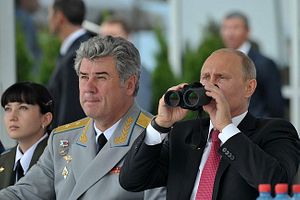Russia’s first combat unmanned aerial vehicle (UAV) will enter into service sometime in 2020, a senior Russian official has said.
According to Russian state media, Deputy Defense Minister Yury Borisov recently said Moscow would begin research and development on the combat UAV this year with plans to begin testing it in 2017. “We are ready to consider starting a development work this year with plans to complete it and move on to the official tests or experimental military use of future devices in 2017,” Borisov said, according to RIA Novosti.
Last month, Russia’s Defense Ministry said that Moscow would spend upwards of $9.2 billion on UAVs through 2020. This was up from the $8.8 billion Russia intended to spend through 2020.
Russia has compared the Skad combat UAV it is developing to the American-made Х-47. The Skad is reportedly 10 tons with a 4,000 km range and a speed of at least 800 km per hour. According to Russia & India Report, the Skad combat UAV will be capable of “carrying two air-to-surface/anti-radiation missiles or two smart bombs with a total weight of no more than one ton.” The same article noted that Russia has given a contract tender to the Sukhoi design bureau for a combat UAV that is being called X-40, however, little is known about the characteristics of that particular drone.
Russian news reports suggest that America’s use of drones in Afghanistan and Pakistan are the primary impetus for Moscow’s own drive to build combat UAVs. The reports also suggested the reduced training cost of UAV operators as well as the alleged use of Israeli-made UAVs by Georgia during its 2008 war with Russia as motivating Moscow’s push for drones. Late last year, Russia opened up a new base near Moscow to train UAV operators.
The reports once again highlight the reality that armed drones are likely to proliferate across the world in the coming years. In a report released this month, the Council on Foreign Relations’ Micah Zenko and Sarah Kreps argue: “Russia, China, Iran, South Korea, and Taiwan, for example, have begun to develop increasingly sophisticated indigenous drone capabilities. Other countries, including Pakistan, Turkey, Saudi Arabia, and the United Arab Emirates (UAE), have publicized their intent to purchase them.”
They also argue that: “Drones should be treated as a distinct class of weapons. They have unique properties that lead them to be used, and defended against, in ways that are destabilizing.”
In particular, the authors argue that the presence of armed UAVs will increase countries’ willingness to resort to the use of armed force.
“Governments are more willing to use them over other weapons platforms because the associated costs and risks are assumed to be comparably lower,” Zenko and Kreps write.
Kreps also discusses the issue of drone proliferation in a video embedded below:

































